Improving Nestle's Employee Recruitment and Training Project
VerifiedAdded on 2021/02/19
|31
|5645
|242
Report
AI Summary
This report presents a comprehensive analysis of a project aimed at improving Nestle's employee recruitment, selection, and training processes to align with international requirements. The project begins with defining aims and objectives, followed by a literature review on recruitment, selection, and training. A project management plan is developed, encompassing cost, scope, time, quality, communication, and risk management. A work breakdown structure and Gantt chart are created to visualize project tasks and timelines. The research methodology involves both qualitative and quantitative methods, including questionnaires and data analysis. The report analyzes the collected data using appropriate tools and techniques, culminating in recommendations and conclusions regarding the project's value and effectiveness. The research aims to identify the impact of globalization, benefits and challenges of training and recruitment on overall business functions. The report includes a project management plan, work breakdown structure, Gantt chart, questionnaire, and its interpretation.

Managing a
Successful Business
Project
Successful Business
Project
Paraphrase This Document
Need a fresh take? Get an instant paraphrase of this document with our AI Paraphraser

Table of Contents
Title: “To improve the recruitment, selection and training of their employees to meet
International requirements in context of multinational companies- A case study on Nestle”.........3
INTRODUCTION..................................................................................................................3
TASK 1............................................................................................................................................3
P1 Devise project aims and objectives for a chosen scenario................................................3
LITERATURE REVIEW................................................................................................................4
P2 Produce a project management plan..................................................................................5
P3 Produce a work breakdown structure and a Gantt chart....................................................7
................................................................................................................................................8
TASK 2..........................................................................................................................................10
P4 Carry out small-scale research by applying qualitative and quantitative research methods.
..............................................................................................................................................10
TASK 3..........................................................................................................................................13
P5 Analyse research and data using appropriate tools and techniques................................13
P6 Communicate suitable recommendations as well as effective conclusion......................21
TASK 4..........................................................................................................................................21
P7 Reflect on the value of undertaking the research to meet stated objectives....................21
CONCLUSION..............................................................................................................................22
REFERENCE.................................................................................................................................24
Books & journals..................................................................................................................24
Title: “To improve the recruitment, selection and training of their employees to meet
International requirements in context of multinational companies- A case study on Nestle”.........3
INTRODUCTION..................................................................................................................3
TASK 1............................................................................................................................................3
P1 Devise project aims and objectives for a chosen scenario................................................3
LITERATURE REVIEW................................................................................................................4
P2 Produce a project management plan..................................................................................5
P3 Produce a work breakdown structure and a Gantt chart....................................................7
................................................................................................................................................8
TASK 2..........................................................................................................................................10
P4 Carry out small-scale research by applying qualitative and quantitative research methods.
..............................................................................................................................................10
TASK 3..........................................................................................................................................13
P5 Analyse research and data using appropriate tools and techniques................................13
P6 Communicate suitable recommendations as well as effective conclusion......................21
TASK 4..........................................................................................................................................21
P7 Reflect on the value of undertaking the research to meet stated objectives....................21
CONCLUSION..............................................................................................................................22
REFERENCE.................................................................................................................................24
Books & journals..................................................................................................................24
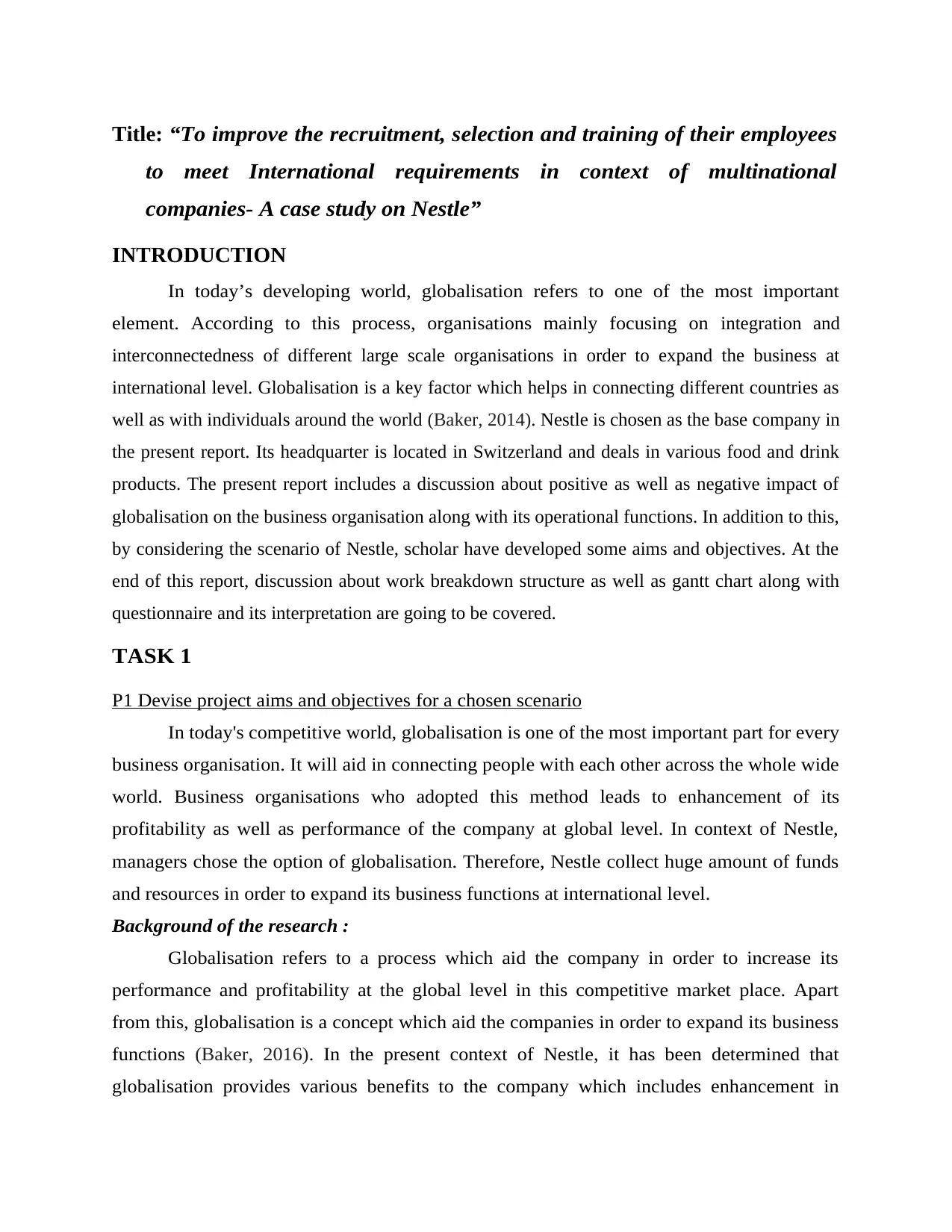
Title: “To improve the recruitment, selection and training of their employees
to meet International requirements in context of multinational
companies- A case study on Nestle”
INTRODUCTION
In today’s developing world, globalisation refers to one of the most important
element. According to this process, organisations mainly focusing on integration and
interconnectedness of different large scale organisations in order to expand the business at
international level. Globalisation is a key factor which helps in connecting different countries as
well as with individuals around the world (Baker, 2014). Nestle is chosen as the base company in
the present report. Its headquarter is located in Switzerland and deals in various food and drink
products. The present report includes a discussion about positive as well as negative impact of
globalisation on the business organisation along with its operational functions. In addition to this,
by considering the scenario of Nestle, scholar have developed some aims and objectives. At the
end of this report, discussion about work breakdown structure as well as gantt chart along with
questionnaire and its interpretation are going to be covered.
TASK 1
P1 Devise project aims and objectives for a chosen scenario
In today's competitive world, globalisation is one of the most important part for every
business organisation. It will aid in connecting people with each other across the whole wide
world. Business organisations who adopted this method leads to enhancement of its
profitability as well as performance of the company at global level. In context of Nestle,
managers chose the option of globalisation. Therefore, Nestle collect huge amount of funds
and resources in order to expand its business functions at international level.
Background of the research :
Globalisation refers to a process which aid the company in order to increase its
performance and profitability at the global level in this competitive market place. Apart
from this, globalisation is a concept which aid the companies in order to expand its business
functions (Baker, 2016). In the present context of Nestle, it has been determined that
globalisation provides various benefits to the company which includes enhancement in
to meet International requirements in context of multinational
companies- A case study on Nestle”
INTRODUCTION
In today’s developing world, globalisation refers to one of the most important
element. According to this process, organisations mainly focusing on integration and
interconnectedness of different large scale organisations in order to expand the business at
international level. Globalisation is a key factor which helps in connecting different countries as
well as with individuals around the world (Baker, 2014). Nestle is chosen as the base company in
the present report. Its headquarter is located in Switzerland and deals in various food and drink
products. The present report includes a discussion about positive as well as negative impact of
globalisation on the business organisation along with its operational functions. In addition to this,
by considering the scenario of Nestle, scholar have developed some aims and objectives. At the
end of this report, discussion about work breakdown structure as well as gantt chart along with
questionnaire and its interpretation are going to be covered.
TASK 1
P1 Devise project aims and objectives for a chosen scenario
In today's competitive world, globalisation is one of the most important part for every
business organisation. It will aid in connecting people with each other across the whole wide
world. Business organisations who adopted this method leads to enhancement of its
profitability as well as performance of the company at global level. In context of Nestle,
managers chose the option of globalisation. Therefore, Nestle collect huge amount of funds
and resources in order to expand its business functions at international level.
Background of the research :
Globalisation refers to a process which aid the company in order to increase its
performance and profitability at the global level in this competitive market place. Apart
from this, globalisation is a concept which aid the companies in order to expand its business
functions (Baker, 2016). In the present context of Nestle, it has been determined that
globalisation provides various benefits to the company which includes enhancement in
⊘ This is a preview!⊘
Do you want full access?
Subscribe today to unlock all pages.

Trusted by 1+ million students worldwide
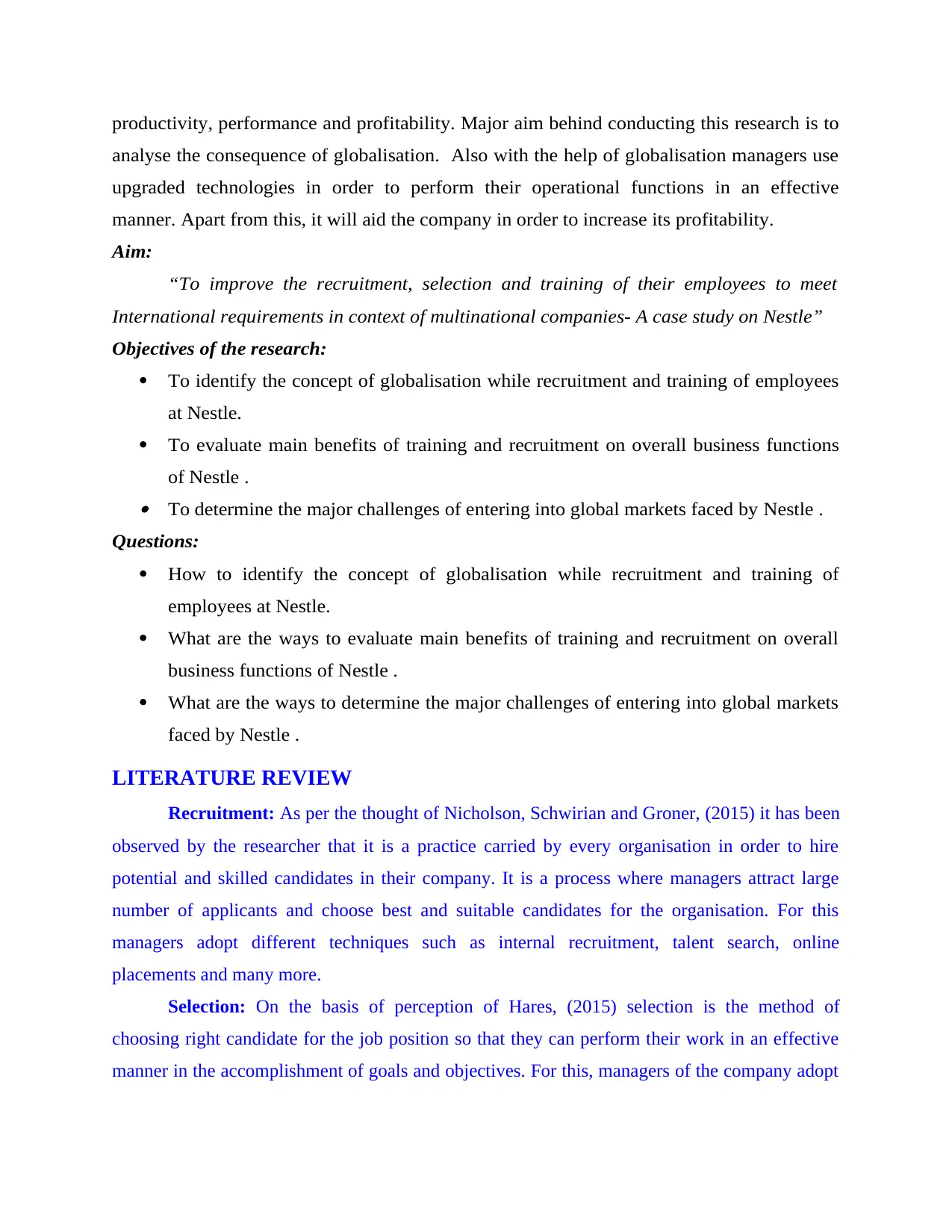
productivity, performance and profitability. Major aim behind conducting this research is to
analyse the consequence of globalisation. Also with the help of globalisation managers use
upgraded technologies in order to perform their operational functions in an effective
manner. Apart from this, it will aid the company in order to increase its profitability.
Aim:
“To improve the recruitment, selection and training of their employees to meet
International requirements in context of multinational companies- A case study on Nestle”
Objectives of the research:
To identify the concept of globalisation while recruitment and training of employees
at Nestle.
To evaluate main benefits of training and recruitment on overall business functions
of Nestle .
To determine the major challenges of entering into global markets faced by Nestle .
Questions:
How to identify the concept of globalisation while recruitment and training of
employees at Nestle.
What are the ways to evaluate main benefits of training and recruitment on overall
business functions of Nestle .
What are the ways to determine the major challenges of entering into global markets
faced by Nestle .
LITERATURE REVIEW
Recruitment: As per the thought of Nicholson, Schwirian and Groner, (2015) it has been
observed by the researcher that it is a practice carried by every organisation in order to hire
potential and skilled candidates in their company. It is a process where managers attract large
number of applicants and choose best and suitable candidates for the organisation. For this
managers adopt different techniques such as internal recruitment, talent search, online
placements and many more.
Selection: On the basis of perception of Hares, (2015) selection is the method of
choosing right candidate for the job position so that they can perform their work in an effective
manner in the accomplishment of goals and objectives. For this, managers of the company adopt
analyse the consequence of globalisation. Also with the help of globalisation managers use
upgraded technologies in order to perform their operational functions in an effective
manner. Apart from this, it will aid the company in order to increase its profitability.
Aim:
“To improve the recruitment, selection and training of their employees to meet
International requirements in context of multinational companies- A case study on Nestle”
Objectives of the research:
To identify the concept of globalisation while recruitment and training of employees
at Nestle.
To evaluate main benefits of training and recruitment on overall business functions
of Nestle .
To determine the major challenges of entering into global markets faced by Nestle .
Questions:
How to identify the concept of globalisation while recruitment and training of
employees at Nestle.
What are the ways to evaluate main benefits of training and recruitment on overall
business functions of Nestle .
What are the ways to determine the major challenges of entering into global markets
faced by Nestle .
LITERATURE REVIEW
Recruitment: As per the thought of Nicholson, Schwirian and Groner, (2015) it has been
observed by the researcher that it is a practice carried by every organisation in order to hire
potential and skilled candidates in their company. It is a process where managers attract large
number of applicants and choose best and suitable candidates for the organisation. For this
managers adopt different techniques such as internal recruitment, talent search, online
placements and many more.
Selection: On the basis of perception of Hares, (2015) selection is the method of
choosing right candidate for the job position so that they can perform their work in an effective
manner in the accomplishment of goals and objectives. For this, managers of the company adopt
Paraphrase This Document
Need a fresh take? Get an instant paraphrase of this document with our AI Paraphraser

various methods for selecting best and capable candidates. Some of these methods includes face
to face interview, telephonic interview, group discussion and many more.
Training: According to the point of view Presbitero, Roxas and Chadee, (2016) training
refers to a systematic development of skills, knowledge and attitude of an individual so that they
can perform their task in an effective manner. Training can be giving to individuals so that they
can perform their personal, organisational, social and other goals in an effective manner.
Managers of the company adopt on the job and off the job training sessions in order to provide
training and development to their employees.
P2 Produce a project management plan
Project management plan refers to a written document which is in a formal manner
develop by the management team. Project management plan is a document approved by the
top authority of company. It is generally formed by the managers in order to manage and
control their current operation in order to get successful implementation of project. With the
help of this plan, managers can create effective communication with their shareholders and
involve them in their project effectively (Blythe and Martin, 2019). Along with this, they
will be able to develop positive and strong relationship with their shareholders. In a project
management plan, there are ample number of elements involved which is scope, size, cost,
quantity, risk and many more. It is the document consist of different factors such as
development and description of various business functions. Some of the important key
elements of a project management plan are going to be discussed below:
Cost: Main part of a project management plan is cost. It refers to the overall
resources and monetary funds which is required by every business organisations in order to
perform their task effectively and completing the project successfully. For this, cost
involved in the project by researcher is £100 pounds.
Scope: Other element involved in the project management plan is scope. It deals with
different aspects of development and growth of a business organisation. Apart from this,
scope includes various future as well as present opportunities for the organisation in order to
enhance their profitability as well as performance at the marketplace (Charter and Polonsky,
2017). Apart from this, it will help the company in order to maintain their stability at the
marketplace. Therefore, for ensuring the growth, managers of the company need to examine
various different factors carefully.
to face interview, telephonic interview, group discussion and many more.
Training: According to the point of view Presbitero, Roxas and Chadee, (2016) training
refers to a systematic development of skills, knowledge and attitude of an individual so that they
can perform their task in an effective manner. Training can be giving to individuals so that they
can perform their personal, organisational, social and other goals in an effective manner.
Managers of the company adopt on the job and off the job training sessions in order to provide
training and development to their employees.
P2 Produce a project management plan
Project management plan refers to a written document which is in a formal manner
develop by the management team. Project management plan is a document approved by the
top authority of company. It is generally formed by the managers in order to manage and
control their current operation in order to get successful implementation of project. With the
help of this plan, managers can create effective communication with their shareholders and
involve them in their project effectively (Blythe and Martin, 2019). Along with this, they
will be able to develop positive and strong relationship with their shareholders. In a project
management plan, there are ample number of elements involved which is scope, size, cost,
quantity, risk and many more. It is the document consist of different factors such as
development and description of various business functions. Some of the important key
elements of a project management plan are going to be discussed below:
Cost: Main part of a project management plan is cost. It refers to the overall
resources and monetary funds which is required by every business organisations in order to
perform their task effectively and completing the project successfully. For this, cost
involved in the project by researcher is £100 pounds.
Scope: Other element involved in the project management plan is scope. It deals with
different aspects of development and growth of a business organisation. Apart from this,
scope includes various future as well as present opportunities for the organisation in order to
enhance their profitability as well as performance at the marketplace (Charter and Polonsky,
2017). Apart from this, it will help the company in order to maintain their stability at the
marketplace. Therefore, for ensuring the growth, managers of the company need to examine
various different factors carefully.
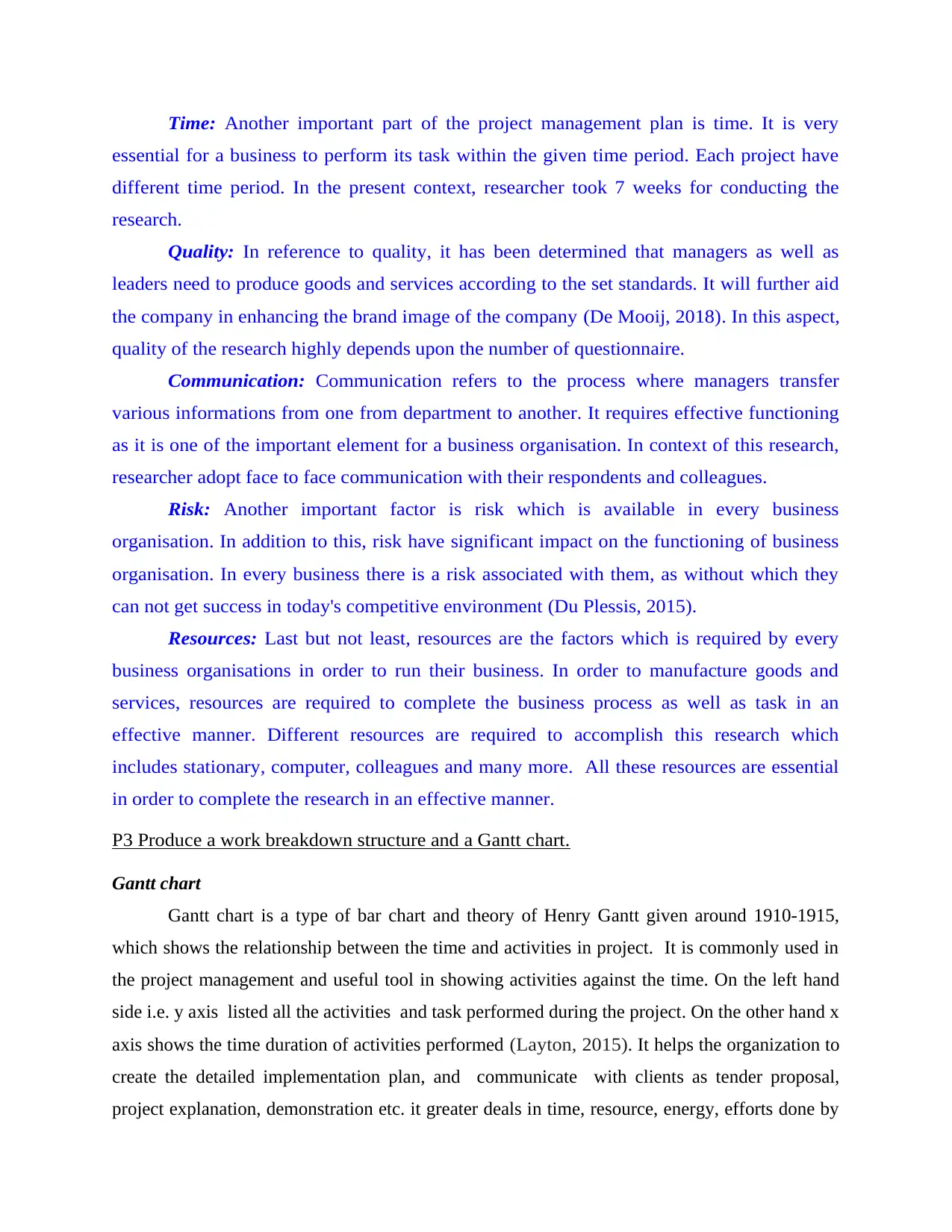
Time: Another important part of the project management plan is time. It is very
essential for a business to perform its task within the given time period. Each project have
different time period. In the present context, researcher took 7 weeks for conducting the
research.
Quality: In reference to quality, it has been determined that managers as well as
leaders need to produce goods and services according to the set standards. It will further aid
the company in enhancing the brand image of the company (De Mooij, 2018). In this aspect,
quality of the research highly depends upon the number of questionnaire.
Communication: Communication refers to the process where managers transfer
various informations from one from department to another. It requires effective functioning
as it is one of the important element for a business organisation. In context of this research,
researcher adopt face to face communication with their respondents and colleagues.
Risk: Another important factor is risk which is available in every business
organisation. In addition to this, risk have significant impact on the functioning of business
organisation. In every business there is a risk associated with them, as without which they
can not get success in today's competitive environment (Du Plessis, 2015).
Resources: Last but not least, resources are the factors which is required by every
business organisations in order to run their business. In order to manufacture goods and
services, resources are required to complete the business process as well as task in an
effective manner. Different resources are required to accomplish this research which
includes stationary, computer, colleagues and many more. All these resources are essential
in order to complete the research in an effective manner.
P3 Produce a work breakdown structure and a Gantt chart.
Gantt chart
Gantt chart is a type of bar chart and theory of Henry Gantt given around 1910-1915,
which shows the relationship between the time and activities in project. It is commonly used in
the project management and useful tool in showing activities against the time. On the left hand
side i.e. y axis listed all the activities and task performed during the project. On the other hand x
axis shows the time duration of activities performed (Layton, 2015). It helps the organization to
create the detailed implementation plan, and communicate with clients as tender proposal,
project explanation, demonstration etc. it greater deals in time, resource, energy, efforts done by
essential for a business to perform its task within the given time period. Each project have
different time period. In the present context, researcher took 7 weeks for conducting the
research.
Quality: In reference to quality, it has been determined that managers as well as
leaders need to produce goods and services according to the set standards. It will further aid
the company in enhancing the brand image of the company (De Mooij, 2018). In this aspect,
quality of the research highly depends upon the number of questionnaire.
Communication: Communication refers to the process where managers transfer
various informations from one from department to another. It requires effective functioning
as it is one of the important element for a business organisation. In context of this research,
researcher adopt face to face communication with their respondents and colleagues.
Risk: Another important factor is risk which is available in every business
organisation. In addition to this, risk have significant impact on the functioning of business
organisation. In every business there is a risk associated with them, as without which they
can not get success in today's competitive environment (Du Plessis, 2015).
Resources: Last but not least, resources are the factors which is required by every
business organisations in order to run their business. In order to manufacture goods and
services, resources are required to complete the business process as well as task in an
effective manner. Different resources are required to accomplish this research which
includes stationary, computer, colleagues and many more. All these resources are essential
in order to complete the research in an effective manner.
P3 Produce a work breakdown structure and a Gantt chart.
Gantt chart
Gantt chart is a type of bar chart and theory of Henry Gantt given around 1910-1915,
which shows the relationship between the time and activities in project. It is commonly used in
the project management and useful tool in showing activities against the time. On the left hand
side i.e. y axis listed all the activities and task performed during the project. On the other hand x
axis shows the time duration of activities performed (Layton, 2015). It helps the organization to
create the detailed implementation plan, and communicate with clients as tender proposal,
project explanation, demonstration etc. it greater deals in time, resource, energy, efforts done by
⊘ This is a preview!⊘
Do you want full access?
Subscribe today to unlock all pages.

Trusted by 1+ million students worldwide
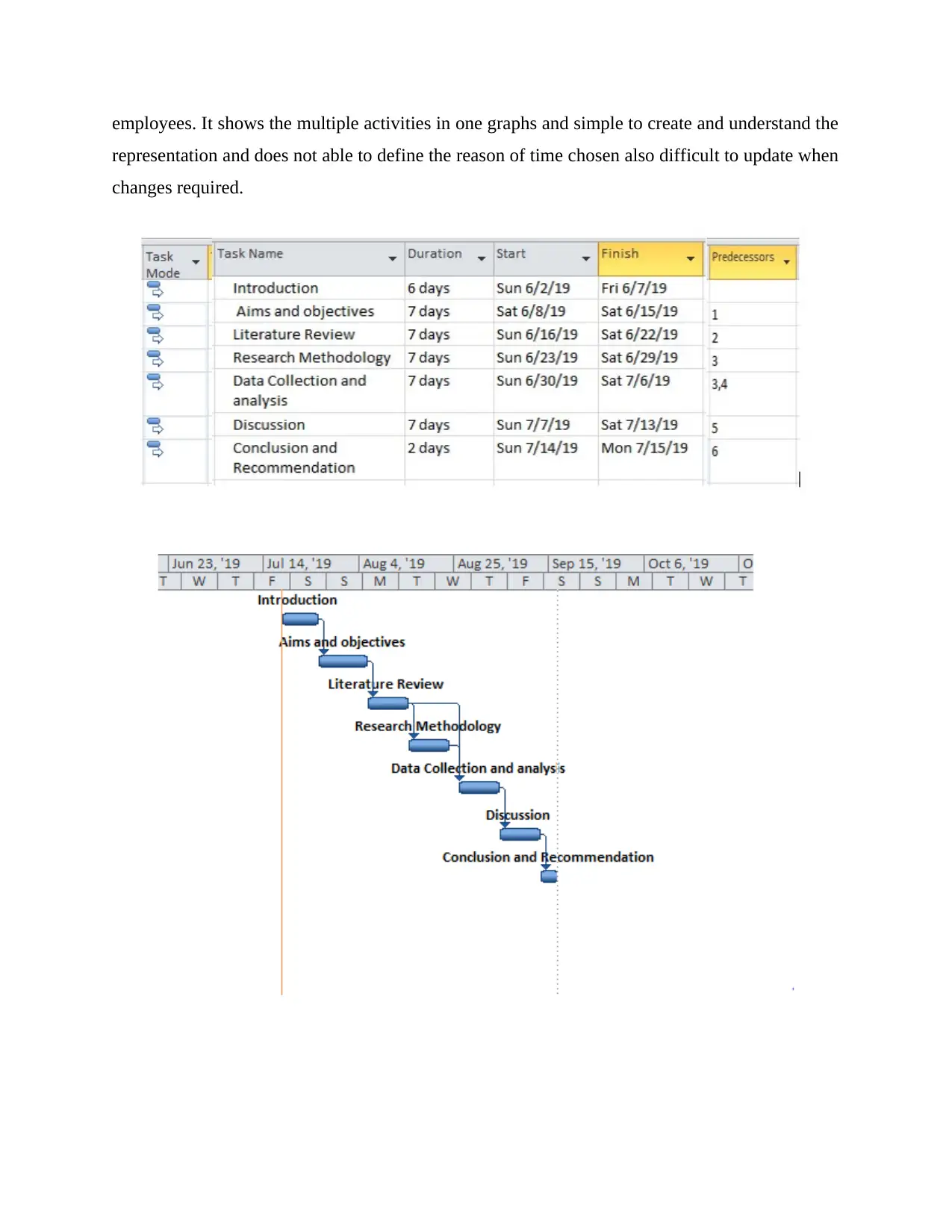
employees. It shows the multiple activities in one graphs and simple to create and understand the
representation and does not able to define the reason of time chosen also difficult to update when
changes required.
representation and does not able to define the reason of time chosen also difficult to update when
changes required.
Paraphrase This Document
Need a fresh take? Get an instant paraphrase of this document with our AI Paraphraser
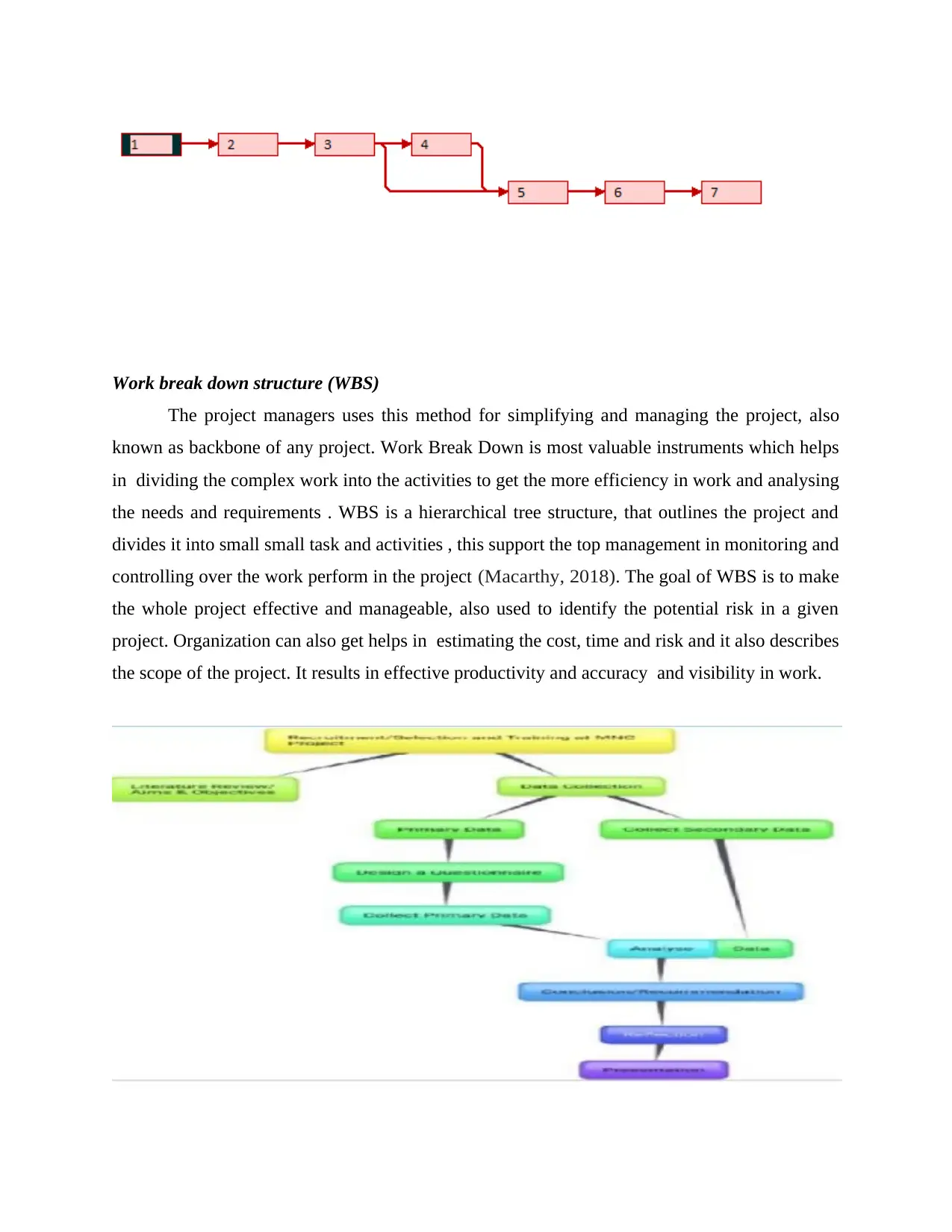
Work break down structure (WBS)
The project managers uses this method for simplifying and managing the project, also
known as backbone of any project. Work Break Down is most valuable instruments which helps
in dividing the complex work into the activities to get the more efficiency in work and analysing
the needs and requirements . WBS is a hierarchical tree structure, that outlines the project and
divides it into small small task and activities , this support the top management in monitoring and
controlling over the work perform in the project (Macarthy, 2018). The goal of WBS is to make
the whole project effective and manageable, also used to identify the potential risk in a given
project. Organization can also get helps in estimating the cost, time and risk and it also describes
the scope of the project. It results in effective productivity and accuracy and visibility in work.
The project managers uses this method for simplifying and managing the project, also
known as backbone of any project. Work Break Down is most valuable instruments which helps
in dividing the complex work into the activities to get the more efficiency in work and analysing
the needs and requirements . WBS is a hierarchical tree structure, that outlines the project and
divides it into small small task and activities , this support the top management in monitoring and
controlling over the work perform in the project (Macarthy, 2018). The goal of WBS is to make
the whole project effective and manageable, also used to identify the potential risk in a given
project. Organization can also get helps in estimating the cost, time and risk and it also describes
the scope of the project. It results in effective productivity and accuracy and visibility in work.

⊘ This is a preview!⊘
Do you want full access?
Subscribe today to unlock all pages.

Trusted by 1+ million students worldwide

TASK 2
P4 Carry out small-scale research by applying qualitative and quantitative research methods.
Research Methodology
Research is a collection of data and information through different tools and techniques. It
helps to enhance the knowledge of the researcher. The main objective is to resolve the problem
and issues. There are certain methods which has to be conducted during the research period. The
research is one of the important part of study. The data once collected by the researcher then
certain techniques and graphs are used to research more attractive. There are two important
methods which are qualitative and quantitative research. Both the methods are discussed below :-
Qualitative research : Qualitative research focuses on the behavioural aspect about the
individuals. The data and information is collected for first time (Miles and et. al., 2015)
(Sajid, 2016). The questionnaire which are prepared in this research is open ended that
means the respondents can write opinions and suggestions in the questionnaire which the
researcher can analyse ideology of the individual. The respondents are randomly
selected and has to give answers according to the individual prospective. The quality
research is majorly concentrate on “why” rather than “what”.
Quantitative research : This research is done on statistical data and information and it
is basically depend. Data analysed through numerical tools and techniques. The
questionnaire is made in rating format and it is closed ended respondents has to limited
information for example questions are made in “yes or “no”. So limited answers are
asked to the individual. In the quantitative research the researcher study is more emphasis
on the study of numerical facts and figures.
Primary sources - The data collection sources is important part of research, when the
researcher do survey directly and collect data from respondents for first time and then is
it called to be primary sources of information. It is important for the researcher to have
good communication skill while interacting with the respondents. Primary researcher is
time consuming then secondary sources. Fundamental source of collecting the data from
the respondents which help the research to work according to the perception of the
customer.
P4 Carry out small-scale research by applying qualitative and quantitative research methods.
Research Methodology
Research is a collection of data and information through different tools and techniques. It
helps to enhance the knowledge of the researcher. The main objective is to resolve the problem
and issues. There are certain methods which has to be conducted during the research period. The
research is one of the important part of study. The data once collected by the researcher then
certain techniques and graphs are used to research more attractive. There are two important
methods which are qualitative and quantitative research. Both the methods are discussed below :-
Qualitative research : Qualitative research focuses on the behavioural aspect about the
individuals. The data and information is collected for first time (Miles and et. al., 2015)
(Sajid, 2016). The questionnaire which are prepared in this research is open ended that
means the respondents can write opinions and suggestions in the questionnaire which the
researcher can analyse ideology of the individual. The respondents are randomly
selected and has to give answers according to the individual prospective. The quality
research is majorly concentrate on “why” rather than “what”.
Quantitative research : This research is done on statistical data and information and it
is basically depend. Data analysed through numerical tools and techniques. The
questionnaire is made in rating format and it is closed ended respondents has to limited
information for example questions are made in “yes or “no”. So limited answers are
asked to the individual. In the quantitative research the researcher study is more emphasis
on the study of numerical facts and figures.
Primary sources - The data collection sources is important part of research, when the
researcher do survey directly and collect data from respondents for first time and then is
it called to be primary sources of information. It is important for the researcher to have
good communication skill while interacting with the respondents. Primary researcher is
time consuming then secondary sources. Fundamental source of collecting the data from
the respondents which help the research to work according to the perception of the
customer.
Paraphrase This Document
Need a fresh take? Get an instant paraphrase of this document with our AI Paraphraser

Secondary sources - Research which is done already by past researcher. The data which
are collected through various sources. Journals, books, internet and analysing the past
records of researchers. It saves time and is less expensive. Helps to improve depth
knowledge. The secondary source of data is collected, depending on other researchers
experience and tools and techniques. Journals and books are best source for the collection
of data but it has some limitations.
Data collection The raw information which is unorganized that are gathered together to
resolve the problems that are going to faces by the researcher during the research. The
word data means know facts .Data is a type of information which is divided into two
parts primary and secondary collection of data (Tuten and Solomon, 2017). Data is
limitless it need to organised in a systematic way. The information is once collected then
certain tools and techniques are used to make the data appropriate for the research.
Information are pool but researchers set parameters according to that research is done.
In the present report, primary as well as secondary method is used by the researchers in
order to gather information. For collecting primary data, total number of respondents are
15.
Questionnaire it is a set of questions in a print form. Questionnaire is a research
instrument consisting of series of information which is made for a specific purpose. It one
of important tool to collect inform from the respondents. The data is important source of
research. Questionnaire is a way through which research can be done and can analyse the
individual perception towards the research topic. This is a important tool to conduct a
survey in a best and conveniently way. The pool of raw information is divided into
certain questions for the respondents to know about perception towards the topic.
Questionnaire
Q 1) Do you have awareness about the term related to globalization in relation to recruiting
and providing training to employees?
a) Yes
b) No
Q2) What are the ways in which globalisation impact on the function which are performed
are collected through various sources. Journals, books, internet and analysing the past
records of researchers. It saves time and is less expensive. Helps to improve depth
knowledge. The secondary source of data is collected, depending on other researchers
experience and tools and techniques. Journals and books are best source for the collection
of data but it has some limitations.
Data collection The raw information which is unorganized that are gathered together to
resolve the problems that are going to faces by the researcher during the research. The
word data means know facts .Data is a type of information which is divided into two
parts primary and secondary collection of data (Tuten and Solomon, 2017). Data is
limitless it need to organised in a systematic way. The information is once collected then
certain tools and techniques are used to make the data appropriate for the research.
Information are pool but researchers set parameters according to that research is done.
In the present report, primary as well as secondary method is used by the researchers in
order to gather information. For collecting primary data, total number of respondents are
15.
Questionnaire it is a set of questions in a print form. Questionnaire is a research
instrument consisting of series of information which is made for a specific purpose. It one
of important tool to collect inform from the respondents. The data is important source of
research. Questionnaire is a way through which research can be done and can analyse the
individual perception towards the research topic. This is a important tool to conduct a
survey in a best and conveniently way. The pool of raw information is divided into
certain questions for the respondents to know about perception towards the topic.
Questionnaire
Q 1) Do you have awareness about the term related to globalization in relation to recruiting
and providing training to employees?
a) Yes
b) No
Q2) What are the ways in which globalisation impact on the function which are performed
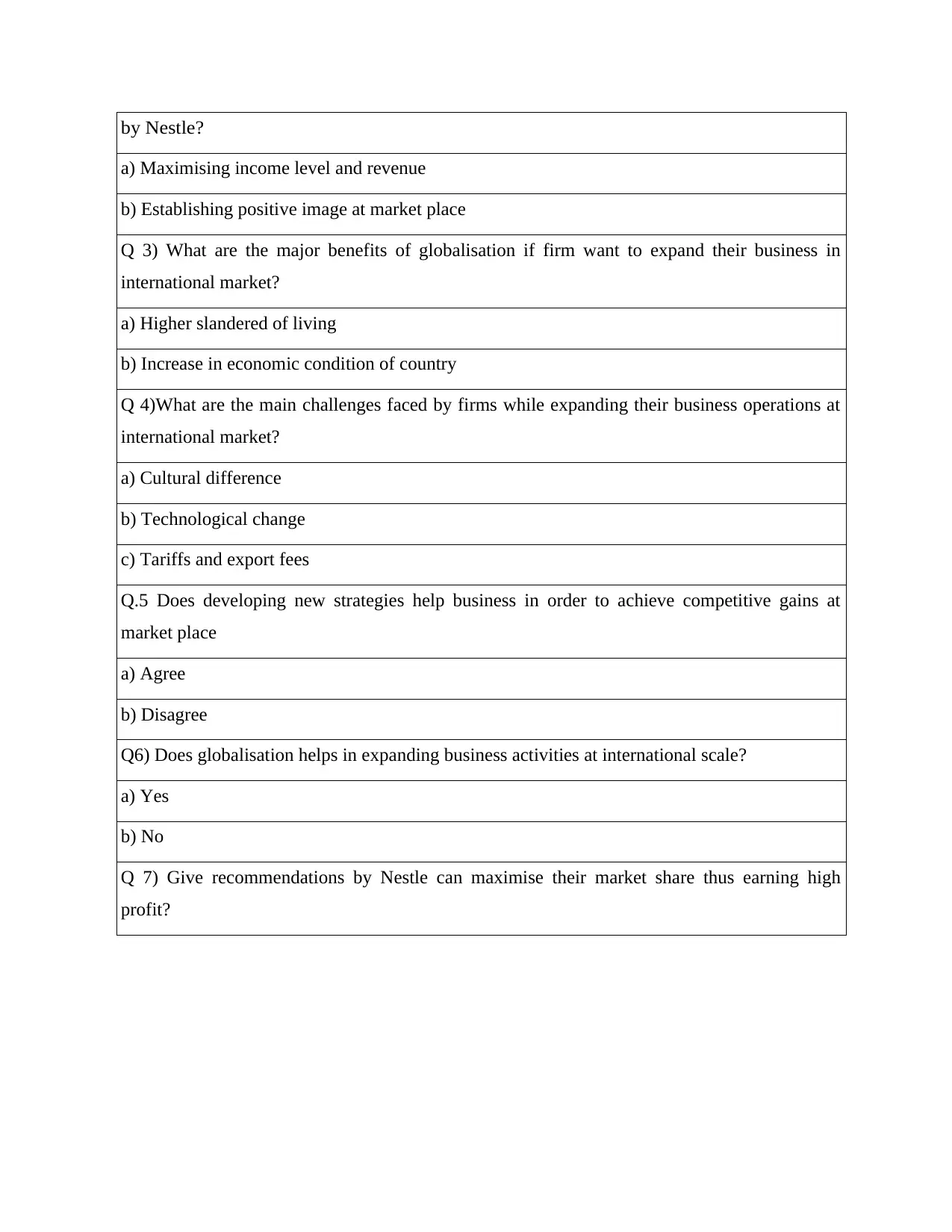
by Nestle?
a) Maximising income level and revenue
b) Establishing positive image at market place
Q 3) What are the major benefits of globalisation if firm want to expand their business in
international market?
a) Higher slandered of living
b) Increase in economic condition of country
Q 4)What are the main challenges faced by firms while expanding their business operations at
international market?
a) Cultural difference
b) Technological change
c) Tariffs and export fees
Q.5 Does developing new strategies help business in order to achieve competitive gains at
market place
a) Agree
b) Disagree
Q6) Does globalisation helps in expanding business activities at international scale?
a) Yes
b) No
Q 7) Give recommendations by Nestle can maximise their market share thus earning high
profit?
a) Maximising income level and revenue
b) Establishing positive image at market place
Q 3) What are the major benefits of globalisation if firm want to expand their business in
international market?
a) Higher slandered of living
b) Increase in economic condition of country
Q 4)What are the main challenges faced by firms while expanding their business operations at
international market?
a) Cultural difference
b) Technological change
c) Tariffs and export fees
Q.5 Does developing new strategies help business in order to achieve competitive gains at
market place
a) Agree
b) Disagree
Q6) Does globalisation helps in expanding business activities at international scale?
a) Yes
b) No
Q 7) Give recommendations by Nestle can maximise their market share thus earning high
profit?
⊘ This is a preview!⊘
Do you want full access?
Subscribe today to unlock all pages.

Trusted by 1+ million students worldwide
1 out of 31
Related Documents
Your All-in-One AI-Powered Toolkit for Academic Success.
+13062052269
info@desklib.com
Available 24*7 on WhatsApp / Email
![[object Object]](/_next/static/media/star-bottom.7253800d.svg)
Unlock your academic potential
Copyright © 2020–2025 A2Z Services. All Rights Reserved. Developed and managed by ZUCOL.





